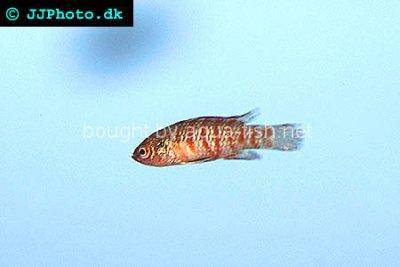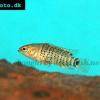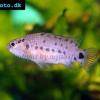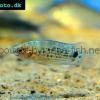Scarlet badis - Dario dario
Scientific name: Dario dario
Common name: Scarlet badis
Family: Badidae
Usual size in fish tanks: 1 - 2 cm (0.39 - 0.79 inch)
014
Recommended pH range: 6.3 - 7
Recommended water hardness: 6 - 18°N (107.14 - 321.43ppm)
0°C 32°F30°C 86°F
Recommended temperature range: 23 - 27 °C (73.4 - 80.6°F)
The way how these fish reproduce: Spawning
Where the species comes from: South Asia
Temperament to its own species: peaceful to females
Temperament toward other fish species: peaceful
Usual place in the tank: Middle levels
Short description
The Scarlet badis (Dario dario) is a tiny, jewel-colored badid from India. Males stake out thumbnail-sized territories and display vivid scarlet bars, while females are smaller and plain. Despite their size, they are selective micro-predators that need calm, densely planted nano tanks with gentle filtration and plenty of leaf litter, wood, and moss to feel secure. Keep one male with 2–3 females to avoid male-on-male aggression.
Origin
Native to India (West Bengal/Assam; Brahmaputra drainage). Found in slow, shallow margins and weed-choked ditches with soft, slightly acidic to neutral water, gentle flow, and dense vegetation.
Food and feeding
A picky micro-predator. Offer live or frozen small foods: newly hatched brine shrimp (Artemia nauplii), daphnia, cyclops, grindal worms, microworms, vinegar eels, and moina. They may learn to take high-quality micro-pellets or fine flakes, but weaning takes patience. Bloodworms and mysis are often too large—either chop them finely or avoid. Feed several small meals daily so they have time to hunt.
Sexing
Males are brighter with distinct red bars and extended fins; females are smaller, beige-silver, and rounder when ripe.
Breeding
Dario dario spawns in tiny cavities (leaf curls, clumps of moss, narrow crevices). The male courts the female and then guards the eggs until hatching; after that he may lose interest in fry care. Use slightly acidic, very clean water with abundant moss (Java moss) and small hiding spots. Eggs hatch in about 2–3 days, and the fry are extremely small—start with infusoria, rotifers, or vinegar eels, then move to Artemia nauplii.
Lifespan
Typically 3–5 years with excellent care (6 years is exceptional).
Behavior & compatibility
Males are territorial toward other males. They do best in species-only nano setups or with very peaceful, tiny tank mates that are not food competitors. Avoid fast, boisterous species; Scarlet badis are slow and shy feeders. Dwarf shrimp may be at risk, especially juveniles.
Tank requirements
- Tank size: at least 20–30 liters for 1 male 2–3 females; larger volumes provide more stability.
- Aquascape: dense planting, leaf litter, driftwood, Java moss, and narrow hiding places (leaf tubes, cones, etc.).
- Filtration: very gentle (sponge filter), low flow, and pristine water quality.
- Water: pH ~6.3–7.0, soft to moderately hard; stability is more important than chasing exact numbers.
Scarlet badis (Dario dario) rarely accept flake food or pellets when first introduced. They thrive on live and frozen micro-foods such as baby brine shrimp, daphnia, cyclops, microworms, grindal worms, vinegar eels, and moina. Bloodworms or mysis are usually too large unless chopped very finely. Offer several small meals daily to match their natural hunting behavior.
Pictures
Bought by aqua-fish.net from jjphoto.dk.



 Badis
Badis  Badis
Badis  Burmese
Burmese